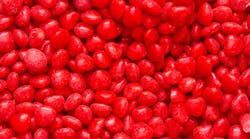California Gov. Gavin Newsom officially signed into law Assembly Bill 418, which prohibits the use of four food and drink ingredients to be used in any products sold in the state effective Jan. 1, 2027.
The four ingredients — brominated vegetable oil, potassium bromate, propylparaben and red dye No. 3 — had been targeted as dangerous to human health by the authors of the bill and their supporters, and Newsom stated in his announcement of the signing that the ban was a positive step forward for public health “until the United States Food and Drug Administration (FDA) reviews and establishes national updated safety levels for these additives.”
The bill, titled the California Food Safety Act, was passed by the California legislature in September, but the version that was passed removed a fifth ingredient, titanium dioxide, from the ban. All five ingredients (including titanium dioxide) have been banned in Europe. This is the first such ban of ingredients deemed permissible by the FDA in the U.S.
These ingredients have been shown to cause various health issues in some studies when given to animal subjects in large amounts, but whether the ingredients truly pose a threat to human health at the small levels at which they are present in foods has been hotly debated by activists and industry alike.
In a statement sent to Food Processing and shared online, the National Confectioners Association (NCA) said, “They’re making decisions based on soundbites rather than science. Governor Newsom’s approval of this bill will undermine consumer confidence and create confusion around food safety.”
The statement adds that the law replaces a uniform national food safety system with a patchwork of inconsistent state requirements created by legislative fiat that will increase food costs.
“This is a slippery slope that the FDA could prevent by engaging on this important topic,” the NCA says. “We should be relying on the scientific rigor of the FDA in terms of evaluating the safety of food ingredients and additives.”
The International Association of Color Manufacturers (IACM) also chimed in last month, specifically on the inclusion of red dye No. 3 on the list, stating in part: “No regulatory authority, including FDA, the European Food Safety Authority (EFSA), and the Joint FAO/WHO Expert Committee on Food Additives (JECFA), has found credible safety concerns with FD&C Red No. 3 and maintains it is safe for use in food.”


